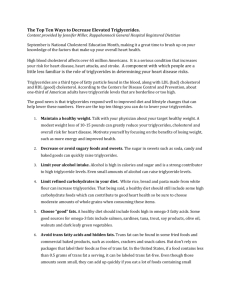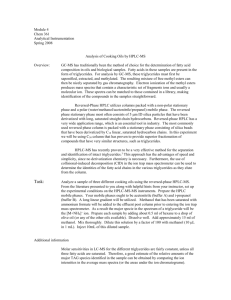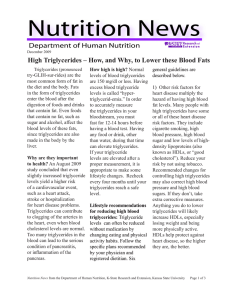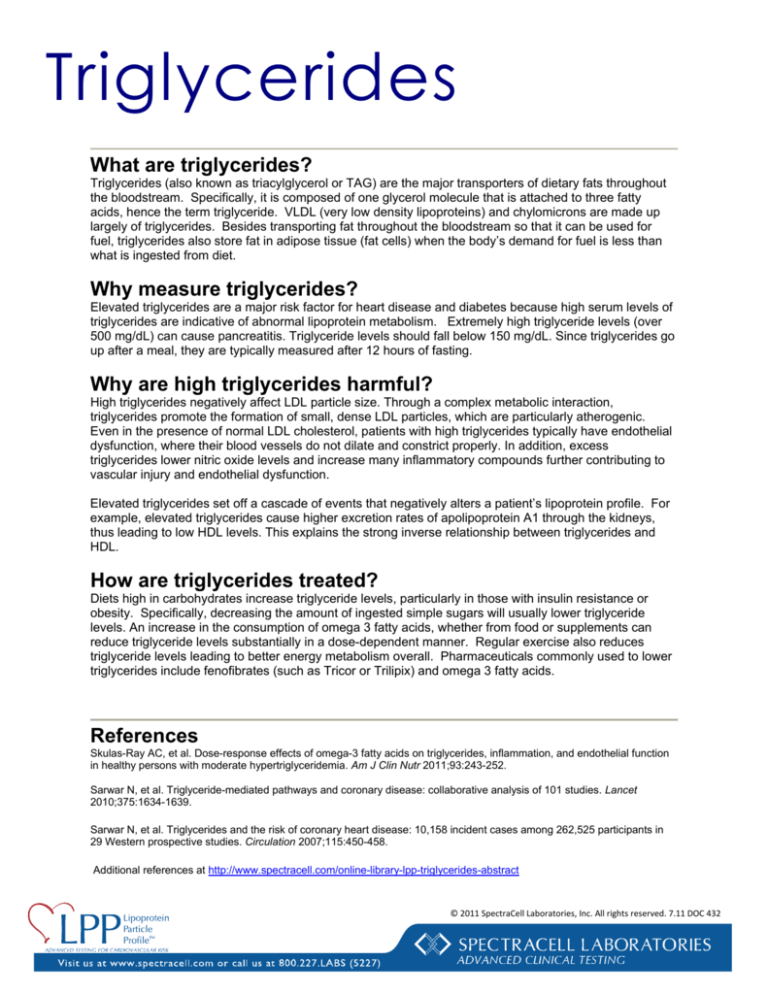
Triglycerides
What are triglycerides?
Triglycerides (also known as triacylglycerol or TAG) are the major transporters of dietary fats throughout
the bloodstream. Specifically, it is composed of one glycerol molecule that is attached to three fatty
acids, hence the term triglyceride. VLDL (very low density lipoproteins) and chylomicrons are made up
largely of triglycerides. Besides transporting fat throughout the bloodstream so that it can be used for
fuel, triglycerides also store fat in adipose tissue (fat cells) when the body’s demand for fuel is less than
what is ingested from diet.
Why measure triglycerides?
Elevated triglycerides are a major risk factor for heart disease and diabetes because high serum levels of
triglycerides are indicative of abnormal lipoprotein metabolism. Extremely high triglyceride levels (over
500 mg/dL) can cause pancreatitis. Triglyceride levels should fall below 150 mg/dL. Since triglycerides go
up after a meal, they are typically measured after 12 hours of fasting.
Why are high triglycerides harmful?
High triglycerides negatively affect LDL particle size. Through a complex metabolic interaction,
triglycerides promote the formation of small, dense LDL particles, which are particularly atherogenic.
Even in the presence of normal LDL cholesterol, patients with high triglycerides typically have endothelial
dysfunction, where their blood vessels do not dilate and constrict properly. In addition, excess
triglycerides lower nitric oxide levels and increase many inflammatory compounds further contributing to
vascular injury and endothelial dysfunction.
Elevated triglycerides set off a cascade of events that negatively alters a patient’s lipoprotein profile. For
example, elevated triglycerides cause higher excretion rates of apolipoprotein A1 through the kidneys,
thus leading to low HDL levels. This explains the strong inverse relationship between triglycerides and
HDL.
How are triglycerides treated?
Diets high in carbohydrates increase triglyceride levels, particularly in those with insulin resistance or
obesity. Specifically, decreasing the amount of ingested simple sugars will usually lower triglyceride
levels. An increase in the consumption of omega 3 fatty acids, whether from food or supplements can
reduce triglyceride levels substantially in a dose-dependent manner. Regular exercise also reduces
triglyceride levels leading to better energy metabolism overall. Pharmaceuticals commonly used to lower
triglycerides include fenofibrates (such as Tricor or Trilipix) and omega 3 fatty acids.
References
Skulas-Ray AC, et al. Dose-response effects of omega-3 fatty acids on triglycerides, inflammation, and endothelial function
in healthy persons with moderate hypertriglyceridemia. Am J Clin Nutr 2011;93:243-252.
Sarwar N, et al. Triglyceride-mediated pathways and coronary disease: collaborative analysis of 101 studies. Lancet
2010;375:1634-1639.
Sarwar N, et al. Triglycerides and the risk of coronary heart disease: 10,158 incident cases among 262,525 participants in
29 Western prospective studies. Circulation 2007;115:450-458.
Additional references at http://www.spectracell.com/online-library-lpp-triglycerides-abstract
© 2011 SpectraCell Laboratories, Inc. All rights reserved. 7.11 DOC 432

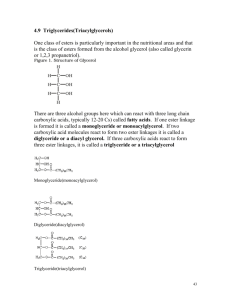



![Lipolysis[1] - IHMC Public Cmaps](http://s2.studylib.net/store/data/005358142_1-87bcfc0fc3c32a571191c55d07580764-300x300.png)

